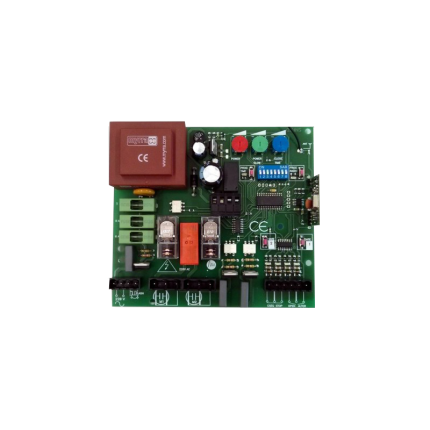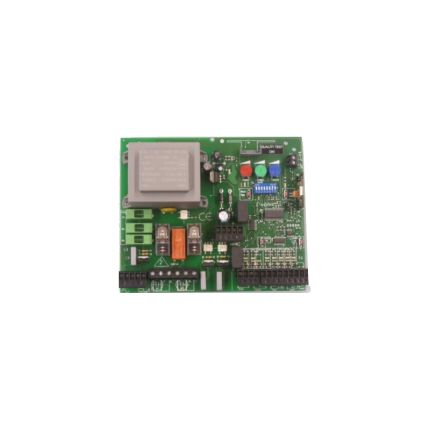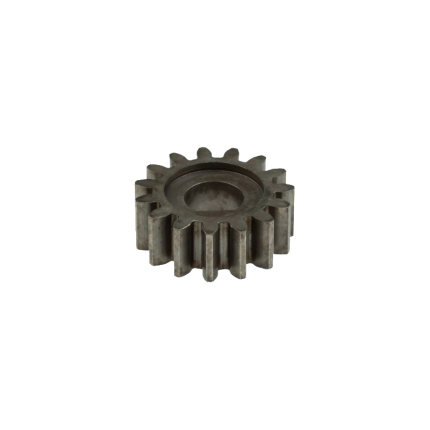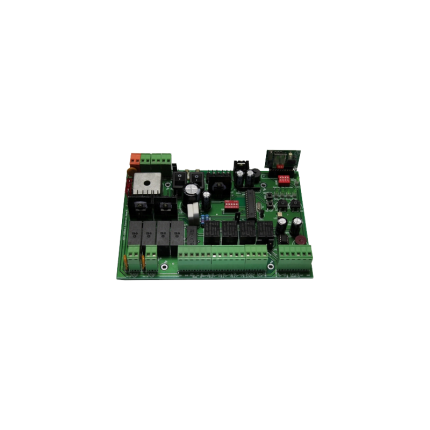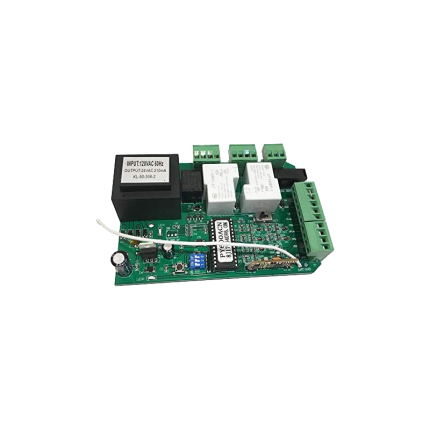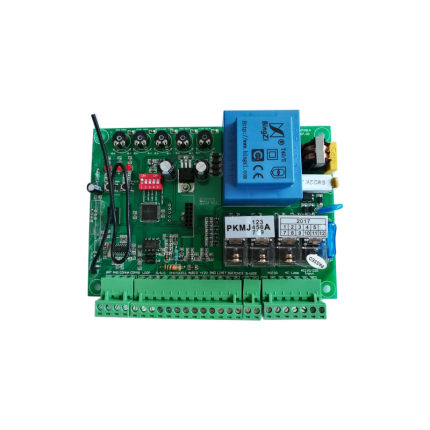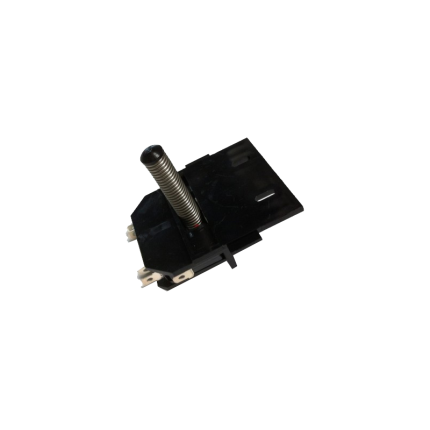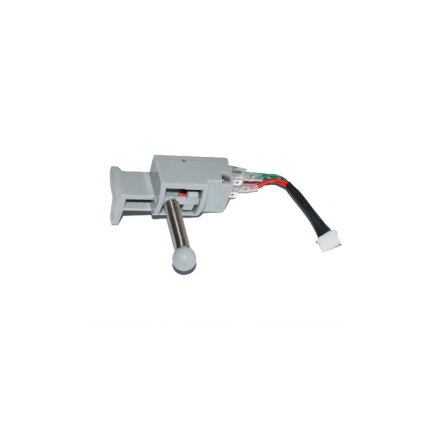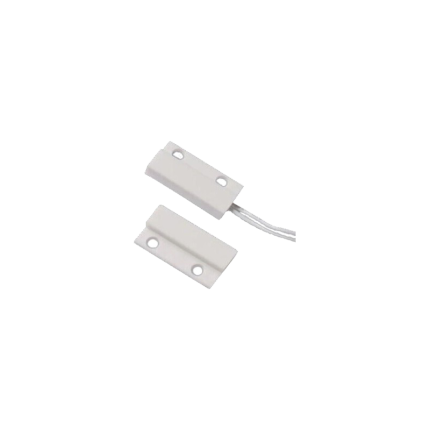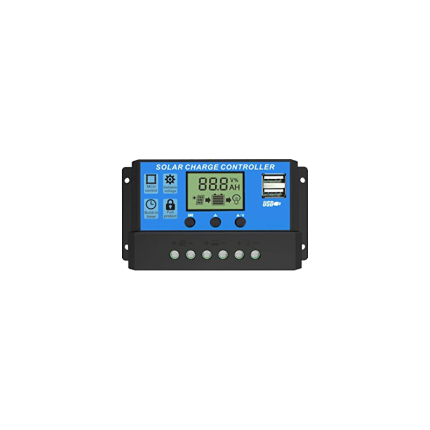Accessories
Swing gate operator main control board – Zero
Ship or pick up from our office.
Swing gate operator main control board - Zero
The "Zero" swing gate operator's main control board is a programmable, multifunctional control unit for swing gates, often used with VDS underground electromechanical motors.
It acts as the "brain" of the system, managing all gate operations and receiving signals from various input devices.
Key features and functions of the Zero swing gate operator's main control board:
-
Central Control:It manages all aspects of the gate operation, acting as the central hub for signals and commands.
-
Signal Processing:Receives signals from remote controls, keypads, safety sensors, and other input devices.
-
Motor Activation:Based on the input received, it sends instructions to the gate motor to open or close the gate.
-
Adjustable Settings:Allows for customization of gate speed, opening/closing times, and safety features.
-
Safety Features:Implements security protocols like locking mechanisms and safety features.
-
Internal Receiver:Many models have a built-in radio receiver for remote control operation, often operating at 433 MHz.
-
Power Supply:Typically operates with a specific voltage input, such as 120V or 24V DC, and may have an output for powering accessories.
-
Compatibility:Some models are designed for universal compatibility with various swing gate openers and systems.
-
Battery Backup:Some models offer battery backup for continued operation during power outages.
-
Other features:May include features like quick close, soft start/stop, and anti-tailgate functions, depending on the specific model.
Swing gate operator’s main control board – VDS & Difermatic
Ship or pick up from our office.
Swing gate operator main control board - VDS & Difermatic
The swing gate operator main control board is the central processing unit that manages all the functions of the gate opener.
It receives signals from remote controls, keypads, or safety sensors, and then translates these into actions for the gate's motor and other components.
Essentially, it's the brain of the gate operator, coordinating all its movements and safety features.
Here's a more detailed look at its functions:
-
Signal Processing:The main control board receives input from various sources like remote controls, keypads, or safety sensors.
-
Motor Control:Based on the input, it sends signals to the gate's motor to open or close the gate.
-
Adjustable Settings:Many main control boards allow for adjustments to settings like gate speed, opening/closing times, and safety features.
-
Safety Features:It manages safety mechanisms like obstruction detection, which stops or reverses the gate if it encounters an obstacle.
-
Access Control:It can manage access by integrating with keypads, intercoms, and other access control systems.
-
Power Management:The main control board manages the power supply to the motor and other components, including battery backup systems for power outages.
-
Communication:It can also communicate with other devices and systems, like alarm systems, for enhanced security.
-
Universal Compatibility:Some main control boards, like the SWRG24, are designed to be compatible with a wide range of swing gate openers and systems.
Sliding gate operator’s gear
Universal Swing gate operator’s main control board SWRG110
Universal Sliding gate operator’s main control board SLRG110
Universal sliding gate operator control board SLRG24
Ship or pick up from our office.
Universal sliding gate operator control board SLRG24
The Universal Sliding Gate Operator Control Board SLRG24 is the "brain" of an automatic sliding gate system. It's designed to be a versatile replacement or core component for various DC-powered sliding gate operators, meaning it can control a wide range of motors and integrate with different accessories. Here's a detailed look at its features and significance: Core Function of a Control Board: The control board is the central electronic unit that:- Receives Signals: Interprets commands from remote controls, keypads, safety sensors (photocells, shock sensors, loop detectors), intercom systems, and other access control devices.
- Processes Logic: Decides what action the gate should take based on the received signals and its programmed settings (e.g., open fully, partially open for pedestrian, close, stop, reverse due to obstruction).
- Activates Motor: Sends the appropriate electrical signals to the gate motor to start, stop, or reverse its movement.
- Manages Accessories: Controls the power and operation of connected safety and convenience accessories like flashing lights, electric locks, and alarm outputs.
- Universal Compatibility: This is its defining characteristic.
- DC Motor Compatibility: It's designed to work with both DC 12V and DC 24V motors. This flexibility is crucial as many sliding gate operators use one of these DC voltages. It's important to note that it is NOT compatible with AC (Alternating Current) motors (like 110V or 220V AC motors).
- Limit Switch Flexibility: It can work with both spring-type mechanical limit switches and magnetic limit switches. This is a significant advantage for a universal board, as it means it can be used with a wider range of existing gate operators.
- Input Power: The board itself typically requires an AC 24V input power. This means it likely has an internal transformer or is designed to be powered by an external AC 24V transformer.
- Full Programmability: Offers a wide range of adjustable parameters, allowing customization of gate operation to suit specific needs:
- Gate Speed: Adjustment of how fast the gate opens and closes.
- Opening/Closing Times: Setting precise durations for gate cycles.
- Automatic Closing Time: Programming a delay before the gate automatically closes after opening (e.g., 15, 30, 45 seconds, or up to 3 minutes).
- Safety Settings: Integration and management of safety sensors (photocells, obstacle detection sensitivity).
- Pedestrian Mode: Ability to set a partial opening for pedestrian access.
- Party Mode: Often allows for temporary cancellation of auto-close for periods when many visitors are expected.
- Remote Control Capability:
- Features an integrated radio receiver, typically operating at 433.92MHz with rolling code technology. Rolling code prevents unauthorized cloning of remote controls, enhancing security.
- Supports multiple remote controls (e.g., up to 20 or more), making it suitable for larger families or multi-user environments.
- Accessory Output Power: Provides DC 24V accessory output power (e.g., 200mA max) to power various external devices:
- Safety Sensors (Photocells): Connects to and powers safety beams.
- Warning Flash Lights: Powers a flashing beacon that activates when the gate is in motion.
- Keypads/Intercom Systems: Provides power and input connections for wired access control devices.
- Electric Locks: Can manage the operation of an electric lock for added security.
- Safety Mechanisms:
- Obstacle Detection: Uses current sensing or other methods to detect if the gate encounters an obstruction during movement. Upon detection, it will typically stop or reverse the gate for safety.
- Automatic Stop Function: Ensures the gate stops precisely at its programmed limits.
- Short Circuit Protection: Often includes protection for output circuits (e.g., lock output) to prevent damage from wiring faults.
- Solar System Input: The mention of "Input Solar system" suggests it's designed to be compatible with or directly connect to solar charging systems for off-grid gate installations, making it suitable for rural properties or areas without easy access to AC power.
- Installation and Durability:
- Designed for relatively easy installation.
- Built with robust components for long-lasting performance in various weather conditions, though it usually requires housing in a waterproof box (often included in a kit).
- Features an automatic power-off memory function, retaining settings after a power outage.
- Replacing a Faulty Board: If an existing 12V or 24V DC sliding gate operator has a non-functional control board, the SLRG24 could be a suitable and cost-effective replacement, reducing the need to replace the entire gate motor.
- New Custom Gate Systems: It provides a flexible "brain" for custom-built sliding gate systems where the motor and other components are chosen separately.
- Solar-Powered Gates: Its solar input capability is a definite advantage for properties in Surrey or surrounding areas that might prefer or require solar power for their gate.
Warning Flash Light
Ship or pick up from our office.
Warning Flash Light
A driveway gate warning flash light (also commonly called a flashing beacon or safety light) is a safety accessory for automatic driveway gates. Its primary purpose is to provide a clear visual signal to pedestrians, cyclists, and vehicles that the gate is in motion (opening or closing) or about to move. Why are they important? Automatic gates, especially large or fast-moving ones, can pose a safety hazard if their movement isn't clearly indicated. A warning flash light enhances safety by:- Alerting Pedestrians: People walking or cycling near the gate might not hear the gate opener motor, especially if there's ambient noise. A flashing light provides an immediate visual cue that the gate is active, encouraging them to stay clear.
- Warning Vehicles: Drivers approaching the driveway might not immediately notice a gate beginning to open or close, especially at night or in adverse weather conditions. The flashing light draws their attention to the gate's movement, preventing potential collisions.
- Visibility in Poor Conditions: In fog, rain, snow, or at night (all relevant for Surrey, BC's climate), the flashing light significantly improves the gate's visibility.
- Compliance with Safety Standards: While not always legally mandated for residential gates, many gate automation safety standards (and good practice) recommend or require warning lights, particularly for commercial or high-traffic gates. Installing one helps ensure a safer operation.
- Feedback to the User: For the gate owner, the flashing light also provides a visual confirmation that the gate has received the command and is indeed operating.
- Flashing Action: The light typically flashes intermittently (strobes) to maximize its attention-grabbing effect.
- Color: Most commonly amber (orange/yellow) or red, as these colors are universally recognized as warning signals.
- Power Source: Designed to be wired into the gate operator's control board. They typically operate on low voltage (e.g., 12V, 24V DC, or sometimes universal 12-265V AC/DC) provided by the gate opener's power supply.
- LED vs. Incandescent: Modern warning lights almost exclusively use LEDs (Light Emitting Diodes) because they are:
- More energy-efficient.
- Have a much longer lifespan.
- Are brighter and more visible than traditional incandescent bulbs.
- Weatherproof: As they are mounted outdoors, they are built to be weatherproof (e.g., IP54, IP65, or IP67 rated) to withstand rain, dust, and temperature variations.
- Integrated Antenna (Optional but common): Many modern warning lights include a built-in antenna for the gate's radio receiver. This can extend the range of remote controls, which is a practical dual function, especially for long driveways.
- Mounting: Designed for easy mounting on a post, wall, or the gate opener's column.
- Audible Alerts (Optional): Some advanced models may also include a small buzzer or chime to provide an audible warning in addition to the visual flash.
Sliding gate operator limit sensor -Spring
Ship or pick up from our office.
Sliding gate operator limit sensor -Spring
A sliding gate operator limit sensor with a spring mechanism (also known as a mechanical limit switch or spring limit switch) is a common type of sensor used in automatic sliding gate systems to define the gate's fully open and fully closed positions. Here's how it works and what its characteristics are: Purpose of a Limit Sensor: For any automatic gate operator, the system needs to know exactly when the gate has reached its desired open and closed positions. This is crucial for:- Stopping the Motor: Preventing the motor from continuing to run once the gate has reached its limit, which would otherwise cause damage to the gate, the motor, or the track.
- Safety: Ensuring the gate stops precisely where it should, preventing it from hitting obstacles or over-extending.
- Proper Operation: Allowing for features like auto-closing, pedestrian mode, and proper synchronization if it's a dual-gate system.
- Components: A spring limit switch typically consists of:
- A microswitch (an electrical switch that requires very little force to operate).
- A spring-loaded lever, arm, or plunger connected to the microswitch.
- A mounting bracket to attach it to the gate operator or gate frame.
- Mounting: The spring limit switch is usually positioned on the gate operator itself, or on a bracket near the motor.
- Interaction with the Gate:
- On the sliding gate itself, usually along the gear rack or a specific part of the gate frame, two small "stop" tabs or flags are installed – one for the open limit and one for the close limit.
- As the gate moves towards its fully open or fully closed position, one of these tabs/flags will physically contact and push against the spring-loaded lever/plunger of the limit switch.
- This physical contact compresses the spring and activates the microswitch.
- Signal to Control Board: When the microswitch is activated, it sends an electrical signal to the gate operator's main control board.
- Motor Stop: Upon receiving this signal, the control board immediately cuts power to the motor, stopping the gate precisely at that determined limit.
- Physical Contact: The defining feature is that it relies on direct physical contact and force to activate the switch.
- Reliability: Generally reliable as they are a simple mechanical system.
- Durability: Made to withstand repeated physical contact. However, over time, the spring can wear out, lose tension, or the switch itself can be damaged by repeated impacts or debris.
- Adjustability: The position of the "stop" tabs on the gate can be adjusted to fine-tune the exact open and closed positions of the gate.
- Maintenance: May require periodic checks to ensure the spring is intact, the switch is clean, and the "stop" tabs are securely in place and correctly positioned. They can be susceptible to damage from impacts (e.g., if a child's toy or a pet gets in the way of the stop tab).
- Compared to Magnetic Limit Switches:
- Magnetic Limit Switches: These are more common in newer and higher-end gate operators (like many BFT Deimos "Ultra" models). They use magnets attached to the gate and magnetic sensors (reed switches or Hall effect sensors) on the operator. They offer a "contactless" operation, which generally leads to less wear and tear, greater precision, and less susceptibility to environmental debris or physical impact damage.
- Spring/Mechanical Limit Switches: Are typically more cost-effective and simpler in design. They are still widely used, especially in more budget-friendly or older gate operator models.
Sliding gate operators limit sensor -Spring
Ship or pick up from our office.
Sliding gate operator limit sensor -Spring
A sliding gate operator limit sensor with a spring mechanism (also known as a mechanical limit switch or spring limit switch) is a common type of sensor used in automatic sliding gate systems to define the gate's fully open and fully closed positions. Here's how it works and what its characteristics are: Purpose of a Limit Sensor: For any automatic gate operator, the system needs to know exactly when the gate has reached its desired open and closed positions. This is crucial for:- Stopping the Motor: Preventing the motor from continuing to run once the gate has reached its limit, which would otherwise cause damage to the gate, the motor, or the track.
- Safety: Ensuring the gate stops precisely where it should, preventing it from hitting obstacles or over-extending.
- Proper Operation: Allowing for features like auto-closing, pedestrian mode, and proper synchronization if it's a dual-gate system.
- Components: A spring limit switch typically consists of:
- A microswitch (an electrical switch that requires very little force to operate).
- A spring-loaded lever, arm, or plunger connected to the microswitch.
- A mounting bracket to attach it to the gate operator or gate frame.
- Mounting: The spring limit switch is usually positioned on the gate operator itself, or on a bracket near the motor.
- Interaction with the Gate:
- On the sliding gate itself, usually along the gear rack or a specific part of the gate frame, two small "stop" tabs or flags are installed – one for the open limit and one for the close limit.
- As the gate moves towards its fully open or fully closed position, one of these tabs/flags will physically contact and push against the spring-loaded lever/plunger of the limit switch.
- This physical contact compresses the spring and activates the microswitch.
- Signal to Control Board: When the microswitch is activated, it sends an electrical signal to the gate operator's main control board.
- Motor Stop: Upon receiving this signal, the control board immediately cuts power to the motor, stopping the gate precisely at that determined limit.
- Physical Contact: The defining feature is that it relies on direct physical contact and force to activate the switch.
- Reliability: Generally reliable as they are a simple mechanical system.
- Durability: Made to withstand repeated physical contact. However, over time, the spring can wear out, lose tension, or the switch itself can be damaged by repeated impacts or debris.
- Adjustability: The position of the "stop" tabs on the gate can be adjusted to fine-tune the exact open and closed positions of the gate.
- Maintenance: May require periodic checks to ensure the spring is intact, the switch is clean, and the "stop" tabs are securely in place and correctly positioned. They can be susceptible to damage from impacts (e.g., if a child's toy or a pet gets in the way of the stop tab).
- Compared to Magnetic Limit Switches:
- Magnetic Limit Switches: These are more common in newer and higher-end gate operators (like many BFT Deimos "Ultra" models). They use magnets attached to the gate and magnetic sensors (reed switches or Hall effect sensors) on the operator. They offer a "contactless" operation, which generally leads to less wear and tear, greater precision, and less susceptibility to environmental debris or physical impact damage.
- Spring/Mechanical Limit Switches: Are typically more cost-effective and simpler in design. They are still widely used, especially in more budget-friendly or older gate operator models.
Magnetic Contact Switch – Wired
Ship or pick up from our office.
Magnetic Contact Switch
A magnetic contact switch, often simply called a magnetic contact or door/window sensor, is a simple yet highly effective security device that detects when a door, window, gate, or any movable barrier is opened or closed. How it Works: It consists of two main parts:- The Sensor Unit (with a Reed Switch): This part contains a reed switch. A reed switch is a small, hermetically sealed (airtight) glass capsule with two tiny, flexible magnetic metal reeds (or contacts) inside. These reeds are usually made of a ferromagnetic material. This sensor unit is typically mounted on the stationary part of the opening (e.g., the door frame, window frame, or gate post).
- The Magnet Unit: This part contains a small, permanent magnet. This unit is mounted on the moving part of the opening (e.g., the door itself, the window sash, or the gate panel).
- Closed Position (Circuit Complete): When the door/window/gate is closed, the magnet unit is in very close proximity to the sensor unit. The magnetic field from the permanent magnet pulls the two tiny reeds inside the glass capsule together, causing them to make electrical contact. This completes an electrical circuit, indicating that the opening is secured.
- Many common contacts are "Normally Open" (NO), meaning the circuit is open when the magnet is away and closes when the magnet is near.
- Some are "Normally Closed" (NC), meaning the circuit is closed when the magnet is near and opens when the magnet is away. This is very common in security systems, as an "open" circuit triggers an alarm.
- Opened Position (Circuit Broken/Changed): When the door/window/gate is opened, the magnet moves away from the reed switch. As the magnetic field weakens, the reeds spring back to their original position, breaking the electrical contact. This change in the circuit (from closed to open, or open to closed, depending on the type) signals the connected system (e.g., a car alarm, home security system, or gate control panel) that the opening has occurred.
- Security Systems (Homes, Businesses, Vehicles): This is the most prevalent use. Magnetic contacts are placed on:
- Doors and Windows: To detect unauthorized entry. When a door or window is opened, it triggers the alarm.
- Garage Doors/Overhead Doors: Larger, more robust magnetic contacts are used for garage doors.
- Gates: Used on pedestrian gates or even main driveway gates (sometimes in conjunction with the gate opener's own limit switches) to monitor their open/closed status for security purposes.
- Safes and Vaults: To detect if they have been opened.
- Vehicle Doors/Trunks/Hoods: While vehicles have internal sensors, magnetic contacts can be added for enhanced security on specific compartments or custom modifications.
- Access Control Systems: To monitor entry and exit points, log access events, or control other devices based on door status.
- Automation Systems: To trigger actions based on the status of a movable part. Examples include:
- Turning lights on/off when a door opens.
- Indicating when a cabinet door is ajar.
- Position sensing in industrial machinery.
- Appliance Safety: Some appliances use magnetic contacts to ensure a lid is closed or a guard is in place before operation.
- Surface Mount: Most common, easily screwed or adhered to the surface of the frame and door.
- Recessed/Flush Mount: Designed to be drilled into the frame and door for a more discreet, hidden installation.
- Heavy Duty/Overhead Door Contacts: Larger and more rugged, built for the heavier use and larger gaps often found with garage or industrial doors.
- Wired vs. Wireless:
- Wired: Physically connected to the alarm panel via wires, offering high reliability.
- Wireless: Contain a small battery and a radio transmitter to send signals wirelessly to the alarm panel, offering easier installation.
PIR Infrared Sensor – wireless
Ship or pick up from our office.
PIR Infrared Sensor – wireless
A wireless PIR (Passive Infrared) sensor is a type of motion detector that uses infrared technology to detect the presence and movement of people, animals, or other warm objects within its field of view, and then transmits this information wirelessly to a central control unit. Here's a breakdown of its key aspects: PIR (Passive Infrared) Technology:- Passive: The "passive" in PIR means the sensor does not emit any energy (like radar or ultrasonic sensors do). Instead, it "passively" detects the infrared radiation (heat energy) naturally emitted by all objects with a temperature above absolute zero.
- Infrared Detection: All living beings (humans, pets) and warm objects emit infrared radiation.
- How it works: A PIR sensor typically has two sensing elements within its housing. When no motion is present, both elements detect the same amount of infrared radiation from the ambient environment. When a warm body moves across the sensor's field of view, it first enters one sensing element's range, causing a rapid change in the infrared energy detected by that element. As the body moves further, it then affects the second element. This differential change in infrared energy between the two elements is what the sensor interprets as motion.
- Fresnel Lens: PIR sensors often have a specialized faceted lens (a Fresnel lens) on their front. This lens helps to focus the infrared radiation onto the sensing elements and creates multiple "detection zones" or "fingers" within the sensor's field of view, which increases its coverage and sensitivity.
- No Wires for Communication: The "wireless" aspect means the sensor communicates with the alarm system's control panel (or receiver) using radio frequencies (RF) rather than physical wires.
- Battery Powered: Wireless PIR sensors are usually battery-powered, making them easy to install anywhere without needing to run electrical wiring. The batteries typically last for a significant period (months to years) before needing replacement.
- Transmitter: Each sensor has a small radio transmitter that sends a signal to the central alarm panel when motion is detected.
- Receiver: The alarm control panel has a built-in or external wireless receiver that listens for signals from the PIR sensors (and other wireless sensors like door/window contacts).
- Easy Installation: No need for complex wiring, making DIY installation simpler and reducing labor costs for professional installers. This is a significant advantage in existing structures where running wires might be difficult or aesthetically unappealing.
- Flexible Placement: Can be mounted virtually anywhere within their effective range of the control panel, providing versatile coverage.
- Reduced False Alarms (Compared to Simple Motion Detectors): Because PIR sensors detect heat signatures, they are less likely to be triggered by non-living things like swaying curtains, blowing leaves, or shadows (though extreme drafts or sudden temperature changes can still be an issue if not properly installed).
- Pet Immunity: Many wireless PIR sensors offer "pet immunity" features. These sensors are designed to ignore the infrared signatures of smaller animals (below a certain weight, e.g., 40 lbs or 80 lbs), helping to prevent false alarms in homes with pets. This is achieved by adjusting the sensor's lens and internal logic to focus on specific infrared patterns that are indicative of human-sized targets.
- Energy Efficiency: As passive devices, they consume very little power, contributing to long battery life.
- Comprehensive Coverage: Ideal for protecting large areas or rooms, as a single sensor can cover a significant space.
- Integration: Seamlessly integrate with smart home security systems, allowing for remote monitoring, alerts via smartphone apps, and sometimes even integration with other smart devices (e.g., turning on lights when motion is detected).
- Home Security Systems: Widely used indoors to detect intruders in living rooms, hallways, bedrooms, and basements. Outdoor-rated versions are also available for perimeter protection.
- Commercial Security Systems: Protecting offices, warehouses, retail spaces, and other commercial properties.
- Automated Lighting: Activating lights in rooms, hallways, or outdoor areas when someone enters.
- Smart Home Automation: Triggering various smart home routines based on occupancy (e.g., adjusting thermostat, playing music).
- Access Control: Monitoring movement in restricted areas.
- Placement: Proper placement is crucial to avoid false alarms. Avoid aiming them directly at heat sources (vents, radiators, direct sunlight, fireplaces), areas with strong drafts, or windows (especially those exposed to direct sun or busy outdoor activity).
- Pet Immunity Settings: If you have pets, ensure the sensor has pet immunity and that it's set correctly for your pet's size and the sensor's mounting height.
- Signal Range: Ensure the sensor is within the wireless range of your alarm panel, considering walls and other obstructions that might weaken the signal.
- Battery Life: Be mindful of battery replacement schedules to ensure continuous operation.

